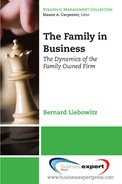Since the definition of a family business remains unclear, I have limited its embrace to the two-generation business where the intent of the owner or founder is to pass the reins on to his son or daughter. The vignettes and case studies offered here have been mostly examples of what can go wrong in these family businesses and why things do go awry. They reflect many of the reasons why the duration of family businesses can be so short, not extending beyond the second generation. However, not all firms that declare themselves to be family businesses are in fact meant to last beyond the first generation. For example, a founder who values his business primarily as a business may feel that the next generation is not up to the task of managing it and, therefore, sells it. Valuing the business as an investment can take precedence over declaring to the next generation working in the business that it will remain in the family. These considerations are generally not taken into account by researchers, thereby confusing the definition of a family business and casting doubt on some of the family business research.
Reading the stories presented here might scare off any business owner from investing his energy in turning his firm into a family business. In fact, many owners have discouraged their children from joining the business because of the fear of worsening their relationship with their offspring. Whenever this has been put forth as the reason for their attitude, one has to wonder what the nature of their relationship is that conflict has to be avoided so assiduously.
This is not to say that conflict should be welcomed with open arms, but rather that conflict and disagreement between the generations is part and parcel of life. How it is resolved is the important aspect. Family businesses present one arena where resolution can enhance the quality of intergenerational relationships because the issues at stake are concrete and specific rather than vague and ephemeral. Disagreeing about terminating an employee, for example, can be argued on its merits, as opposed to some vague “bad blood” description of a father–son relationship. If father bypasses the merits and overrides his daughter’s arguments, this use of power can be clearly identified and questioned. That relationships between parents and offspring do not follow this script in every instance is not the point—family businesses offer the opportunity and the potential for it in a very impressive way. A basic assumption in this text is that one motive for family members to enter the firm founded by their parent is to resolve these basic interpersonal rifts. The fact that resolution frequently does not result does not belie the assumption.
The vignettes highlight problems and are meant to sensitize family members to their underlying dynamics. I would have been remiss to present the problems without offering a method of resolving them. One very important method has been to challenge the owner of a family business to consider the pivotal role he plays in conflict resolution. He has been invited to explore his value system regarding the nature of his business and to be explicit about it with all family members. He has been asked to consider very carefully how his relationship with his spouse affects business decisions and to be frank with her about his intentions, needs, and concerns. Similarly, he has been encouraged to consider how important it is that she be equally open about her intentions, needs, and concerns. Successful transitions require that the founder be clear with management about his goals and, in the process, prepare them for change. One extremely important task for the owner is to provide both his successor and other family members in the business with his evaluation of their ability to function in the business. In brief, the founder’s role in the fate of the business is the most pivotal and the most challenging.
The other method of addressing family business conflict is contained in Appendix A, which outlines in detail how a transition and succession plan might unfold. It invites open dialogue with family members and sets an agenda around which the dialogue can swirl. It suggests that agreements, covenants, and decisions be put to paper, thereby minimizing later misunderstandings as to what was said or agreed on. The document should be updated with any changes so there are no misunderstandings. A periodic review of the transition plan is strongly recommended. The moral of the story is that although succession planning is the eventual outcome of the transition process, and an important one at that, it is only part of the story. For it to be successful, a variety of subplots need to occupy center stage at different points in the telling.
